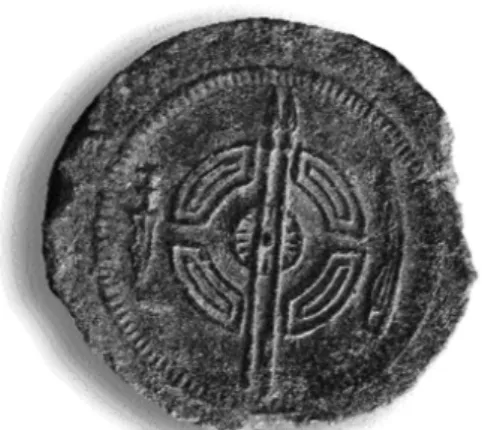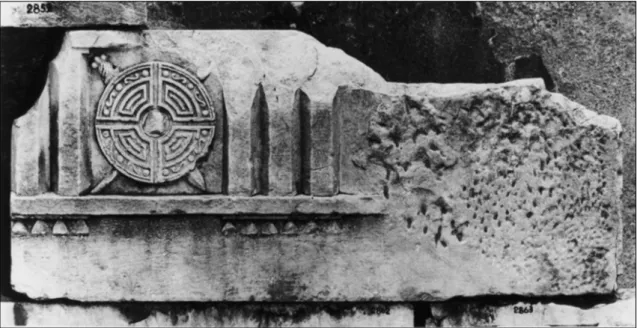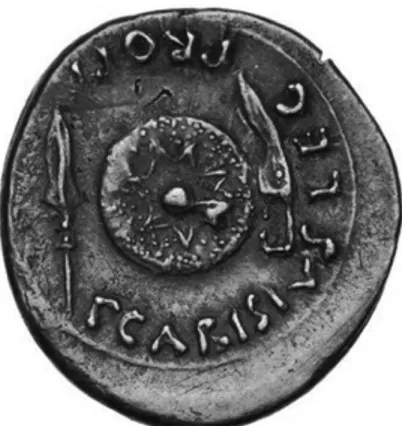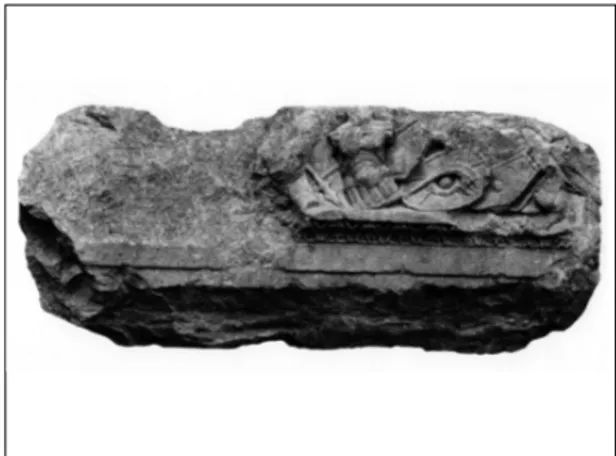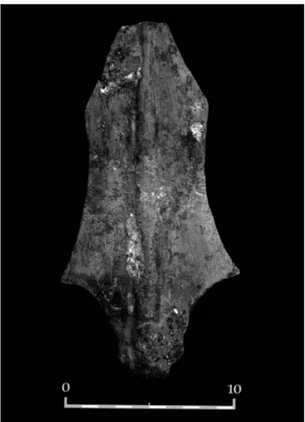SUMMARY
Depicted arms and armour became particularly widespread in the Augustan period, when the Prince’s veterans tended to emphasise their role in the consolidation of the Empire with the adoption of these war themes in their tombs. The compar-ison between some funerary reliefs from Italy, the so-called Lusitanian Warriors, and some monetary emissions from the Iberian Peninsula, together with a recent finding in the Forum of Augustus, allows for the hypothesis that the celebration of Augustan victories in this region could have significantly con-tributed to the repertoire of depicted weapons that celebrated the new Empire.
RESUMEN
Las armas representadas en bajorelieve fueron particular-mente generalizadas en la época de Augusto, cuando los vet-eranos del príncipe tendido a enfatizar su importancia en la consolidación del imperio con la adopción de estos temas de guerra en sus tumbas. La comparación entre algunos relieves funerarios de Italia, los llamados guerreros lusitanos, y algu-nas de las emisiones monetarias de la Península Ibérica, jun-to con un reciente hallazgo desde el Foro de Augusjun-to, permiten plantear la hipótesis de que la celebración de las victorias de Augusto en esta región podría tener significativamente con-tribuido al repertorio de las armas representadas que celebra-ban el nuevo Imperio.
KEY WORDS: Augustan age, Forum Augustum, Roman Spain, Roman relief sculpture, Roman coinage in Spain, Iberian-Celtiberian Weapons, Lusitanian Warriors.
Iconografía triunfal augustea y las guerras cántabras:
algunas observaciones sobre escudos redondos y puntas de lanza
representados en monumentos de la Península Ibérica e Italia
Eugenio Polito Università degli Studi di Cassino
PALABRAS CLAVE: Época augustea, Foro de Augusto, Guerras cántabras, España romana, Escultura de relieve romana, Acuñación de monedas romanas en España, Ar-mas íbero-celtíberas, Guerreros lusitanos.
The iconography of stacked arms and armour, together with those isolated in the metopes of the Doric friezes, characterises a large number of funerary monuments erected by the first generations of Augus-tan followers in Italy (Polito 1998; 2011, with lit.). The extraordinary popularity enjoyed at this stage by this artistic subject among Augustan veterans and settlers cannot be explained without assuming high-level urban models. Nevertheless, the search for ex-amples related to official monuments of this period is not generous with its results. The celebration of the Actium victory of 31 BC in Rome seems to be re-called in an important series of reliefs pertaining to an unknown urban monument, in which the depict-ed objects are not weapons, but instead parts of ships and sacrificial instruments (Hölscher 1985: 84-87 figs. 1-2; Leoncini 1987), a choice that has perhaps to be explained by the desire not to emphasise the bloody aspect of the epilogue of the Civil Wars, which rather required forms of expiation. However, the impact of the commemorative monument of Nicopolis, which contained a frieze with weapons, is yet to be fully assessed (Zachos 2003: 83-85 figs. 28, 30-31; 2007: I, 418 and passim; II, 311 drawing 6; 315 figs. 8-9). It cannot, therefore, be excluded that the ship spoils, which appear frequently in funerary monuments, rest on models created in relation to the Actium victory. * I wish to thank Isabel Rodà de Llanza, Cinzia Vismara
and the two anonymous reviewers for their helpful criti-cism; further Andrea Coletta, Thierry Lejars, Roberto Mene-ghini, Maria Cristina Molinari, Francesca Morandini, Beatri-ce Pinna Caboni, Filli Rossi, FranBeatri-cesco Sirano, and Stefania Tuccinardi for their kind help in different issues regarding this paper.
Figura 1. AE Dupondius. Mint of Northwestern Spain, probably Lugo, after 27 BC. D.: 30,4-29,8 mm.; 18,8 g. Obv.: IMP AVG DIVI F. Head of Augustus l. between palm and caduceus. Rev.: Round shield with labyrinth pattern crossed by two spears or javelins, between celtiberian bi-discoidal pugio and falcata. RPC I, 1992, 2 (Lugo, Sala de Exposicións Porta Miña.
Ayun-tamiento de Lugo, Inv. SD.6).
Figura 2. Graphic reconstruction of the shield worn by a Warrior Statue from Cendufe (Portugal). Lisboa, Museu Na-cional de Arqueologia (from Cabré Aguiló 1940, pl. XVII, 1).
The celebration of the signa recepta after 20 BC, following the restitution of the Roman standards caught by Parthians from Crassus’ legions in the Carrhae defeat of 53 BC, has been convincingly con-nected to a small group of urban reliefs with weap-ons, also from an unknown monument, containing an explicit reference to the Eastern world in the depic-tion of the Parthian tiara (Tempesta 1991/92: 323 figs. 8-9).
Nevertheless, the weapons depicted in the many funerary monuments of the Augustan period show a very diverse repertoire, with many types related to the barbaric West, whose presence cannot be justified only with reference to any monuments celebrating the victory of Actium, or the return of Crassus’ standards. The variety of references to the entire universe of the enemies of Rome suggests the presence of a substrate prepared for a long time, possibly going back to Republican monuments, if not to earlier Hellenistic specimens (examples collected in Polito 1998): the most prominent and already in some sense universal examples are the weapon friezes from the sanctuary of Athena at Pergamon, but it is difficult not to con-sider the Republican coinage, frequently depicting trophies.
The conventional aspect of many decorations must not discourage us: under the veil of an often repeti-tive artistic language and the poor quality of many funerary ornaments of the early Empire, one can still try to distinguish conventional elements from specific types of weapons. Important clues suggest, for exam-ple, that a significant role in the formation of the
weapons-repertoire may have been played by the Cantabrian and Asturian Wars (29–19 BC) (on the Cantabrian Wars see Almagro Gorbea 1999; Rodà 2006, with prev. literature). Some types of weapons carved in early imperial reliefs are in fact unmistak-ably linked to the Iberian world.
This is particularly evident in the case of laby-rinth-patterned round shields depicted on coins related to the wars that took place in the Iberian Peninsula in the early Augustan period (Fig. 1) (RPC I, 1992, 67-68 nr. 1-4 pl. I, 1-4; RPC Suppl. I, 1998, p. 7 with lit.), but also carried by the so-called Lusitanian warrior-statues from Portuguese Galicia (Fig. 2) (Calo Lourido 1994; Quesada Sanz 2003; Die
lusitanisch-galläkischen Kriegerstatuen 2003,nr. 8, p. 9 pls.
6-7): the shield type has been recognised in the
caet-ra of the Iron Age Hispanic populations (Cabré
Aguiló 1939–40; see also Guadán 1979; Quesada Sanz 1997: 489-532). The comparison with weapon friezes from early Imperial grave monuments is strik-ing: a Doric frieze from Rome (Fig. 3) (Mustilli 1938: 186 nr. 104 pl. CXVII, 454; Blanco Freijeiro 1971: 231 pl. II fig. 2), dated as the whole group no later than the first decades of the power of Augustus, and a relief-plate with a flat frame from Pietrabbondan-te Samnitic sanctuary (Fig. 4) (Colonna 1974: pl. XCVIIIa; Cianfarani et alii 1978: 484 pl. 310;
Ita-lia dei Sanniti 2000: 46 fig. 55), show exactly this
type of shield, with the same labyrinth pattern.For the latter, the 2nd century BC dating proposed in previous editions should be rejected; in our opinion it was part of the decoration of a sepulchral
monu-Figura 3. Doric frieze from Porta Flaminia. Rome, Musei Capitolini, Giardino Caffarelli (DAI Rom Inst. Neg. 29.141).
Figura 4. Relief slab from Pietrabbondante (Molise, Italy) (DAI Rom Inst. Neg. 75.2648).
ment erected in the cemetery planted in the area of the samnite sanctuary after the Social War, so prob-ably between the end of the Republic and the early Augustan age. Among various considerations, the comparison with the mentioned coins and monuments has its weight.
Even if the depictions of the labyrinth-caetra on monuments from ancient Callaecia could allow a reference to earlier times, such as the conquest of this region by Brutus Callaicus, who celebrated his tri-umph in 136 BC, the Augustan dating of the above mentioned coins suggests an Augustan chronology also for the creation of the iconography. Significantly, Figura 5. Relief plate from Trasacco in the Marsica region (Abruzzo, Italy). Trasacco (AQ), Oratorio di S. Cesidio (DAI
another example is depicted in a frieze from a mon-ument of Trasacco in ancient Marsica (Abruzzo, It-aly), related to a prominent family of equestrian rank in the area and now convincingly dated to the late Augustan or early Tiberian period (Fig. 5) (Strazzulla 2007).The labyrinth shield is well attested in later times, however, as for instance in an important and neglected frieze from Split (Polito 1998: 155 f. fig. 89) and in the reliefs from Trajan’s Forum (Meneghini 2001: fig. 5; Ungaro 2002: 128 fig. 1).
A similar case is that of a frieze block from an-cient Capua (Fig. 6) (formerly in the garden in front of the Amphitheater of Santa Maria Capua Vetere, unpublished), showing a circular shield with concen-tric rows of studs, which closely resembles denarii probably struck in the Iberian peninsula during the Augustan wars (Fig. 7) (RIC I², 1984, 38; 85 nr. 543 a-b, pl. 10). As in the case of the labyrinth shield, it was supposed to reproduce an indigenous shield,
which was also very likely linked to the Roman vic-tories in the Iberian Northwest. This emission is strict-ly related to another, better known coin series signed by P. Carisius, legatus in Spain in this period, which shows a circular shield decorated with a lozenge-pattern and studs flanked by an Iberian falcata and a long triangular spearhead with concave blades (Fig. 8) (RIC I², 41 nr. 2a-b, pl. 1). The relationship be-tween these two series is attested by a rarer variant coin of the Carisius emission, in which the lozenge-shield is substituted by the one with concentric rows of studs (Fig. 9) (Cohen 1880, 401; Giard 2001: 1033).
The Carisius emissions also include other series with triumphal subjects that have been convincing-ly compared with the so-called “Triumphalprägung” of Octavian (Trillmich 1990: 300-302; García-Bel-lido 2008: 193-195). The whole coin group has been the subject of a long scholarly discussion, involving Figura 6. Tufa stone block with depiction of weapons. S. Maria
Capua Vetere (Caserta, Italy) formerly in the Amphitheatre area (DAI Rom Inst. Neg. 1026 VW 84).
Figura 7. AR Denarius. Uncertain mint (Spain), 27–26 BC; D. 20 mm; 3,86 g. Obv.: head of Octavian r. Rev.: IMP / CAE -SA[R] / DIVI F. - Shield with three rows of concentric studs. RIC I², 1984, 543a (Numismatik Lanz München - Auktion
132 – November 27, 2006 – Lot Nr. 324).
Fig. 8. AR Denarius. Emerita, ca. 25–23 BC. 3.35 g. Obv.: IMP CAESAR AVGVST. Head of Augustus to r. Rev.: P CARISI-VS LEG PRO PR - Shield with lozenge pattern and studs between spear and falcata. RIC I², 1984, 2 a (American
Nu-mismatic Society 1944.100.39019).
Figura 9. AR Denarius, Emerita, ca. 25–23 BC. D.: 20 mm; 4.03 g. Obv.: IMP CAESAR AVGVST. Head to l. Rev.: P CARISIVS LEG PRO PR. Shield with studs between spear and falcata. Cohen 1880, 401; Giard 2001, 1033 (Numismatik Lanz München - Auktion 94 - November 22nd, 1999, Lot Nr. 35).
hypothesis that would require a separate discussion (RIC I², 1984, 8; García-Bellido 2004: 80, with dis-cussion). Nevertheless, without doubt such war sym-bols may be traced to an earlier tradition in the his-tory of the ancient Iberian region: one should compare an emission of Turrirecina (Badajoz), probably dat-ing to the 2nd Century BC and featurdat-ing the caetra with the falcata (García-Bellido and Blázquez 2001: II, 383, nr. 1). If the Turrirecina-coins are to be in-terpreted as symbols of local identity, so the latter emission has also to be seen as a tribute and not sim-ply a trophy (as in other Carisius coins), in gratitude for the already completed conquest: a comparison has been suggested with the iconographic pattern of the Augustan clipeus virtutis (García-Bellido 2008: 193-195, with broader discussion).
However, at least another weapon type depicted on such coins provides an argument in favour of the connection between Italian veteran monuments and the Roman victories in Spain: it is the long spearhead with concave blades, which occurs in the above dis-cussed emissions (figs. 8-9, left), as well as in weapon friezes within the same period. A Padua frieze is
well-imen among preserved spearheads from the Late Iron Age Iberian peninsula: considering the weapons de-picted on the Carisius emission, the Spanish schol-ar Fernando Quesada Sanz came to the conclusion that: “... las armas representadas no son necesaria-mente las armas cántabras, sino la idea o prototipo de arma bárbara y exótica, tomada de la panoplia hispana que los Romanos conocían de antemano
(fal-cata por ejemplo)” (Quesada Sanz 1997: 421 with Pl.
XVA). In fact, similar spearheads from the Caesari-an battlefield of Alesia in Gaul have been ascribed to the Roman army on the base of a very feeble hy-pothesis (Sievers 2001, 161, 224 sg. nr 270-278; 180 fig.13; pl. 62, particularly nr. 274-276). One should also remember that Caesar used, among others, units of Hispanic cavalry, and that similar weapons are depicted on the Mausoleum of the Iulii in St. Remy-de-Provence (Couissin 1923: 311 fig. 3; Rolland 1969: 63 Pls. 27, 31, 42).
Nevertheless, it is beyond doubt that, from the Roman point of view, the panoply on the above dis-cussed emissions recalled a specific Hispanic hori-zon, which cannot be identified, at this historical
Figura 10. Frieze block from Padua. Padova, Italy, Museo Civico, Catalogo delle Collezioni Lapidarie I, n°. 150 (Photo
Courtesy of Musei Civici, Padua, Neg. nr.14416).
Figura 11. Frieze plate walled in the façade of the Monte di Pietà in Piazza della Loggia, Brescia, Italy (Photo Stefano
moment, but with the north-western region in which most military operations took place. That this specific type of spearhead cannot be compared with real find-ings of the area should not be taken as proof against this theory. Together with caetra, falcata, pugio and possibly other weapons, it could have been taken as a symbol of the victories over Cantabri and Astures, thanks also to the typical inexactitude of ancient Ethnology, that, for instance, allowed a Gallic trumpet (carnyx) to be depicted on a trophy of another Car-isius emission, in a perspective that saw perhaps the Cantabri as “relatives” of the Gauls (Trillmich 1990, 300). It is a fact, however, that the discussed spear-heads do not appear in other more typical Celtic or otherwise “barbarian” iconographies, and that the only reliable path leads to the Carisius emissions.
A new archaeological find from the Forum of Augustus could be eventually connected to this spear type and represent a key to the overall reading of the iconography thus far reported. Indeed, a spearhead with concave blades has come to light during recent excavations (Fig. 12) (Coletta & Pinna Caboni 2010: 73-74 fig. 26). It is the opinion of the publishers that
the spearhead was part of an artistic decoration – statue or trophy – rather than a real weapon. The reference to the iconography of the weapon friezes is convincing: the publishers follow the iconographic fortune of this spear type until the panoplies of the Hadrianeum in Rome (Coletta & Pinna Caboni 2010: 74 note 39).
As far as Augustus’s Forum is concerned, it is difficult not to refer to a famous Ovid passage, which alludes to arms, perhaps represented, at the entrance either of Augustus’ Forum or of the Temple of Mars Ultor Fasti 5, 561 f.: “Perspicit (scil. Mars) in fori-bus diversae tela figurae / armaque terrarum milite victa suo”; cp. Zanker 1968: 12). The Forum of Au-gustus became in fact the central place of imperial war policy, in which individual generals were required to deposit their weapons booty (Suet. Aug. 29; Cass. Dio 55, 10, 2 s.). It is no surprise that the repertoire of war symbols created in the aftermath of the last major military campaigns that involved the same Augustus, namely the Cantabrian Wars, was recalled later in the decoration of the Forum of Augustus, which opened in 2 BC.
Figura 12. Spearhead from recent excavations in Augustus’ Forum, Rome (Archivio Fotografico Ufficio Scavi Fori
Impe-riali, Roma – Photo Beatrice Pinna Caboni).
Figura 13. Fragments of frieze and inscription walled in the Tomba dei Rabirii on the Via Appia in Rome (IV Mile)
apparently identical, and the similar chronology of both in the Augustan age. We would not be surprised to discover that the monument iconography eventu-ally included a reference to the wars fought in the Iberian Peninsula at that time.
In conclusion, it is plausible that in the early Augustan age one or more commemorative monu-ments contained references to the Augustan wars in the Iberian Peninsula, the importance of which has been increasingly stressed in recent research (Morillo Cerdán 2002; Pérez-González and Illarregui 2005; Morillo Cerdán 2006; Morillo Cerdán and Aurrec-oechea 2006; García-Bellido 2006). The existence of an Augustan triumphal monument for the bellum
Cantabrum, possibly echoing an older monument
for the Cimbric victory of Marius, has been argued by W. Trillmich based on the comparison of the Carisius emissions with coins struck about 100 BC (Trillmich 1990: 300 f.). The celebration of such a victory would have allowed Augustus to put a Western victory beside the Oriental victory over Antonius – so becoming the peace bringer of the
oecumene – and also to underline a victory in a bel-lum externum, so overshadowing the recently ended bellum civile. It should be pointed out that the lost
autobiography of Augustus was interrupted signi-ficantly in 26 BC, coinciding with the last military campaign conducted personally by the prince. By then, the direct relationship between Octavian’s veterans and their leader came to an end (Rich 2009). For the first generations of soldiers loyal to the prince, it was probably easier to refer to the deca-de-long wars in Spain, with whose celebratory themes they could best identify, rather than to the Actian war. After some eventual Hellenistic exam-ples, and perhaps some unknown late-republican monuments, it is likely, therefore, that the models created at this stage helped to form the basis of the standard repertoire of weapons of the vanquished, so often repeated in many different contexts until late antiquity.
Cianfarani, V.; Franchi Dell’Orto, L. and La Regina, A. 1978: Culture adriatiche di Abruzzo e di
Mo-lise, Roma.
Cohen, H. 1880 : Description historique des monnaies
frappées sous l’Empire romain, Paris-London.
Coletta, A. and Pinna Caboni, B. 2010: “Gli elementi architettonici dallo scavo del Foro di Augusto”, R. Meneghini & R. Santangeli Valenzani (eds.),
Scavi dei Fori imperiali. Il Foro d’Augusto. L’area centrale, Roma, 63-75.
Couissin 1923: “Les guerriers et les armes sur les bas-reliefs du Mausolée des Jules à Saint- Remy”,
Revue Archéologique, 303-321.
Colonna, G. 1974: “Scavi e scoperte”, Studi
etrus-chi 42, 505-555.
Die lusitanisch-galläkischen Kriegerstatuen 2003: Die
lusitanisch-galläkischen Kriegerstatue, Madrider Mitteilungen 44, XI-XX, 1-307.
García-Bellido, M. P. 2004: Las legiones hispánicas
en Germania. Moneda y campamento, Anejos de
Gladius 6, Madrid.
García-Bellido, M. P. 2006: Los campamentos
roma-nos en Hispania (27 a.C.-192 d.C.): el abasteci-miento de moneda, Anejos de Gladius 9, Madrid.
García-Bellido, M. P. 2008: “La representación ico-nográfica de Hispania e hispanos en la Roma re-publicana”, E. La Rocca, P. León and C. Parisi Presicce (eds.), Le due patrie acquisite. Studi di
archeologia dedicati a Walter Trillmich,
Supple-menti del Bullettino della Commissione
Archeo-logica Comunale di Roma 18, Roma, 185-196.
García-Bellido, M. P. and Blázquez, C. 2001:
Dic-cionario de cecas y pueblos hispánicos, Madrid.
Giard, J. B. 2001 : Bibliothèque nationale de
Fran-ce. Catalogue des monnaies de l’Empire romain, I. Auguste, Troisième édition, augmentée et mise
à jour, Paris.
Guadán, A. M. 1979: Las armas en la moneda
ibé-rica, Madrid.
Hölscher, T. 1985: “Denkmäler der Schlacht von Ac-tium. Propaganda und Resonanz”, Klio 67, 81-102.
Italia dei Sanniti 2000: Italia dei Sanniti. Guida alla mostra, Roma 2000, Milano.
Leoncini, L. 1987: “Frammenti con trofei navali e strumenti sacrificali dei Musei Capitolini. Nuo-va ipotesi ricostruttiNuo-va”, Xenia 13, 13-24. Meneghini, R. 2001: “Il Foro di Traiano.
Ricostruzio-ne architettonica e analisi strutturale”, Römische
Mitteilungen 108, 245-268.
Morillo Cerdán, Á. 2002 (coord.): Arqueología
mi-litar romana en Hispania, Madrid.
Morillo Cerdán, Á. 2006 (ed.): Arqueología militar
romana en Hispania II: producción y abasteci-miento en el ámbito militar, León.
Morillo Cerdán, Á. and Aurrecoechea, J. 2006 (eds.):
The Roman army in Hispania: an archaeological guide, León, 151-165.
Mustilli, D. 1938: Il Museo Mussolini, Roma. Passamani, B. 1979: “La coscienza della romanità e
gli studi antiquari tra Umanesimo e Neoclassicis-mo”, Brescia romana. Materiali per un museo II, Brescia, 5-49.
Pérez-González, C. and Illarregui, E. 2005 (eds.):
Arqueología militar romana en Europa. Roman military archaeology in Europe, Segovia.
Polito, E. 1998: Fulgentibus armis. Introduzione allo
studio dei fregi d’armi antichi, Roma.
Polito, E. 2011: La pietrificazione delle armi
conquis-tate, D. Loscalzo and C. Masseria (eds.), Miti di Guerra, riti di pace, Atti del Convegno, Bari,
259-266.
Quesada Sanz, F. 1997: El armamento ibérico.
Es-tudio tipológico, geográfico, funcional, social y simbólico de las armas en la Cultura Ibérica (s. VI-I a.C.), Montagnac.
Quesada Sanz, F. 2003: “¿Espejos de piedra? Las imágenes de armas en las estatuas de los guerre-ros llamados galaicos”, Madrider Mitteilungen 44, 87-112.
RIC I², 1984: Roman Imperial Coinage, I. Revised Edition, London.
Ricci, C. 2006: Qui non riposa. Cenotafi antichi e
moderni fra memoria e rappresentazione, Roma.
Rich, J. 2009: “Cantabrian closure: Augustus Spanish war and the ending of his memoirs”, C. Smith and
A. Powell, (eds.), The lost memoirs of Augustus
and the development of Roman autobiography,
Swansea (Wales), Oxford, Oakville (CT), 145-172. Rodà, I. 2006: “The Cantabrian wars and the reorga-nization of North Hispania: between literary sour-ces, epigraphy and archaeology”, A. Morillo Cer-dán & J. Aurrecoechea (eds.), The Roman army in
Hispania: an archaeological guide, León, 53-63.
Rolland, H. 1969: Le Mausolée de Glanum
(Saint-Rémy-de-Provence) (Gallia Suppl. XXI), Paris. RPC I, 1992: Roman provincial coinage I,
London-Paris.
RPC Suppl I, 1998: Roman provincial coinage,
Su-ppl. I, London-Paris.
Sievers, S. 2001: “Les armes d’Alésia”, Alésia.
Foui-lles et recherches franco-allemandes sur les
tra-vaux militaires romains autour du Mont-Auxois (1991-1997), vol. 2: Le matériel (Mémoires de
l’Académie des Inscriptions et Belles Lettres),
Paris, 121-291.
Strazzulla, M. J. 2007: “Dona et signa: un monumen-to funerario di militari a Trasacco”, Fucino:
stu-di sulla cultura figurativa, Bari, 57-132.
Tempesta, A. 1991/92: “I rilievi con armi Cesi: ipo-tesi di ricomposizione e di interpretazione”,
Bu-llettino della Commissione Archeologica Comu-nale di Roma 94, 2, 309-340.
Ungaro, L. 2002, “I Daci dal Foro di Traiano”, M. De Nuccio and L. Ungaro (eds.): I marmi
colo-rati della Roma imperiale, Exhibition Cat. Rome 2002-2003, Roma, 128-133.
Zachos, K. L. 2003: “The tropaeum of the sea-batt-le of Actium at Nikopolis: interim report”,
Jour-nal of Roman Archaeology 16, 65-92.
Zachos, K. L. 2007: “Ta gluptav tou bwmouv sto Mnhmeivo tou Oktabianouv Augouvstou sth Nikovpolh. Miva prwvth prosevggish”, K.L. Zachos (ed.), Nikovpoli~ B v. Praktikav tou
Deutevrou Dieqnouv~ Sumposivou gia th Ni-kovpolh - Nicopolis B. Proceedings of the Second International Nicopolis Symposium Preveza 2002,
Preveza, I, 411-434; II, 307-321.
Zanker, P. 1968: Forum Augustum. Das
Bildpro-gramm, Tübingen.
Recibido: 11-10-2011 Aceptado: 02-02-2012
